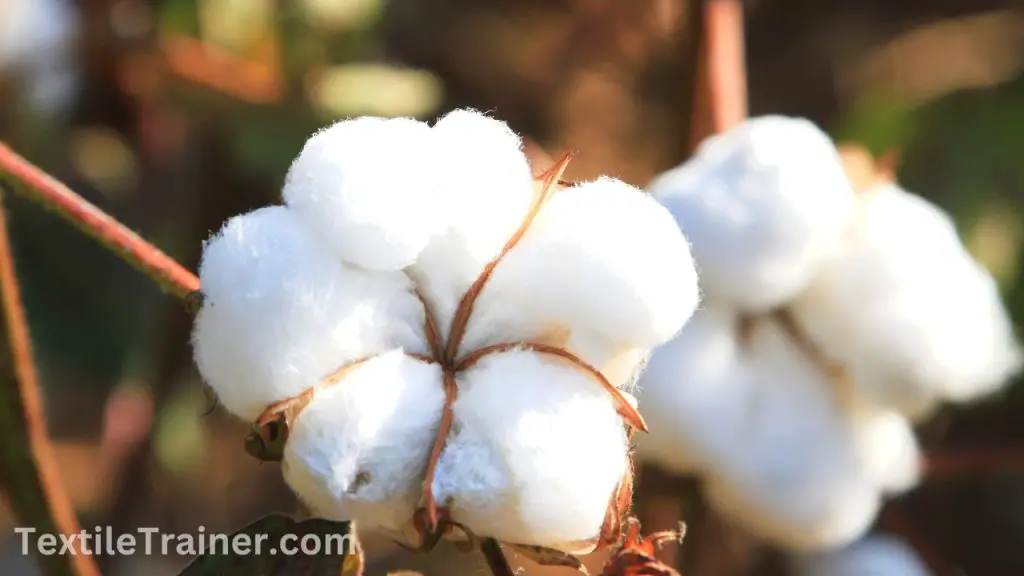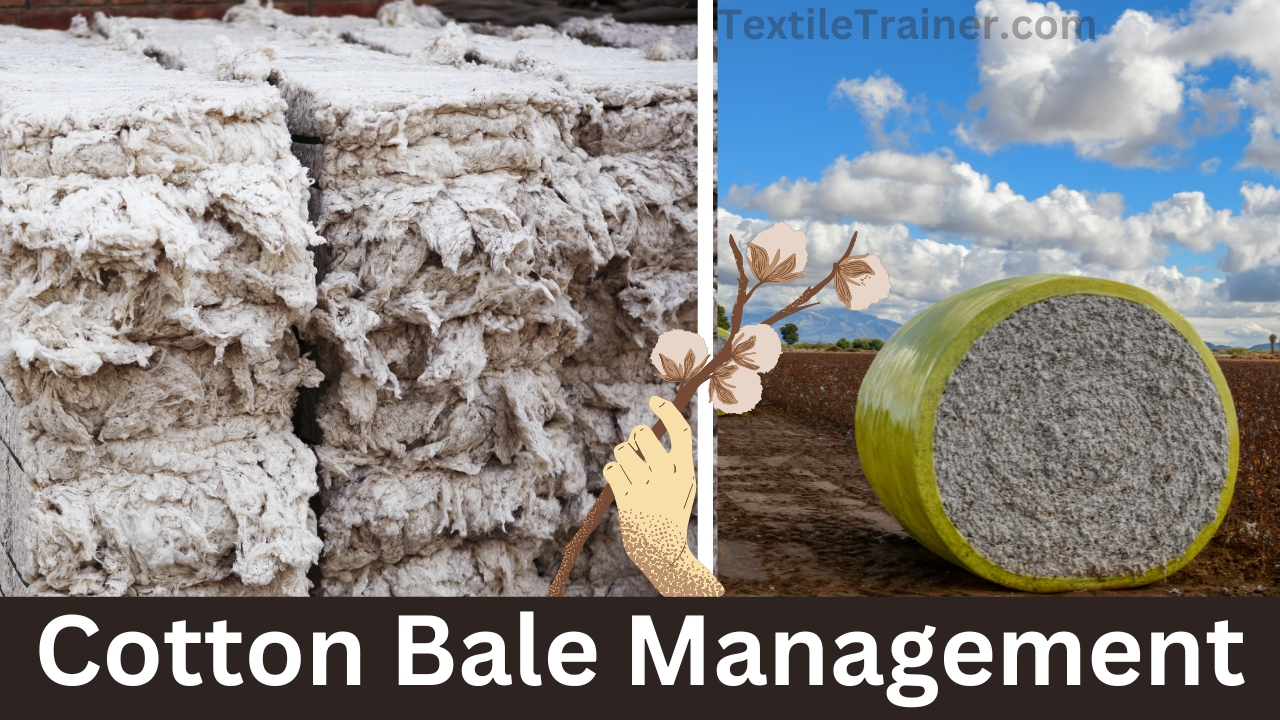What is Cotton Bale Management?
simply, cotton bale management is the management of bale’s selection and bale’s distribution to achieve acceptable quality and cost. According to UsterTM Technology, “the choice of cotton bales according to fiber characteristics in order to achieve acceptable and economical processing condition and a constant yarn quality is called bale management”.
In other word, “Bale management is the selection of bales from the fiber quality database and the distribution of the bales according to the laid down management plan in order to achieve the target quality and cost level.”. Finally we say, bale management is picking the right quality at the right time. In this article, I brief describe objectives and classification of cotton bale management.

Objectives of Bale Management:
All the objects of mixing are fulfilled through the implementation of bale management. Bale management is logical data based mixing whereas “mixing” is general terms of bringing all the component fibers in together for intermingling. Therefore, special purposes or objects which are achieved through the implementation of bale management are sated below.
- To improvise the quality profile of the yarn in term of:
- Mass variation: mass variation which represents the imperfection of the yarn. A yarn made from bale management improvises the mass variation of the yarn like thin, thick and neps.
- End breakage variation: end breakage variation over the process period which is produced from improper raw material selection or improper mixing. Continuation of a spinning process from bale management avoids such type of draw-back i.e high end break frequency.
- Shade variation: shade variation which represents the barre effect in the end product. A export quality end-product with barre effect is ejected by the consumers. Such type quality problem can be avoided through implementation of the data based mixing i.e. bale management.
- To reduce the raw material cost: bale management has influence in reduction of the product’s cost through.
- The usage of maximum number of bales within bale warehouse-the least amount of left over bales.
- The improving the process performance.
- The usage of cheaper raw material with better quality fiber to achieve the desired quality.
- To avoid the quality jump: A bale management process ensures consistency in quality over a long spinning period, i.e avoid quality jump in spinning process.
Bale Management Classification:
- Basis on performing field of evaluation of the steps of bale management is classified into two groups:
- On-line bale management: this is on-field bale management system. In this system, all the steps for bale management are performed and evaluated from cotton fiber level for specific product. Example: EFSTM system from cotton incorporation of USA.
- Off-line bale management: this off-field bale management system. In this system, all the above said steps are performed and evaluated at cotton yarn field level for specific product. Example: BIASTM system from Uster Technologies or Manual program
- Basis on evaluation of fiber properties and technology of bale management is classified into two groups.
- Traditional bale management: this is man eye-evaluated bale management system. Previously bale management were done basis on eye estimation of fiber color of bale. Bales were mixed basis on same or very close color bales. There was maintained regularity in laying down the bales in stacking. Due to manual estimation of fiber properties, a lot of complaints regarding yarn quality were arising and spinning performance were worse.
- Modern bale management: this is machine evaluated bale management system. In modern bale management system, the fiber properties are evaluated by HVI or LVI machine and using the technological value of cotton, bales are laid down according to bale management. As all the fiber properties are considered in this system. Therefore, spinning and post spinning performance is better.
References
- Chowdhury, M. F. (2016). Manual of Short Staple Spinning . Dhaka: Granthanir Prokashoni.
- Hossain, M. S. (2014). Introduction to Textile Engineering. Dhaka: Books Fair Publications.
- Kadolph, S. J. (2009). Textiles. New Delhi: Dorling Kindersley.
- Siddique, D. H. (n.d.). Natural Fibers. Dhaka.







Great info. Lucky me I recently found your blog by accident (stumbleupon). I have book-marked it for later!
thank you..
Fantastic post but I was wondering if you could write a litte more on this subject?I’d be very thankful if you could elaborate a little bit further.Thank you!
ok, I will try.
Thanks again for the blog post.Really thank you! Fantastic.
Keep visit our site…
Very neat blog.Really looking forward to read more. Fantastic.
keep visit our site….
Very good article.Really thank you! Cool.
stay with us.
Appreciate you sharing, great blog post.Really looking forward to read more. Fantastic.
thanks too..
Usually I do not learn article on blogs, but I wish to say that this write-up very pressured me to take a look at and do so! Your writing style has been amazed me. Thank you, very nice article.
please support us.
I truly appreciate this blog article. Awesome.
please support us.
It’s truly a great and helpful piece of information. I am glad that you simply shared this useful info with us. Please stay us informed like this. Thank you for sharing.
thanks too….please support us….
That is a very good tip especially to those new to the blogosphere. Simple but very accurate info… Many thanks for sharing this one. A must read post!
please support us.
Muchos Gracias for your article post. Awesome.
Thanks
Hi! This is my first visit to your blog! We are a group of volunteers and starting a new initiative in a community in the same niche. Your blog provided us beneficial information to work on. You have done a extraordinary job!
Thanks
A round of applause for your blog article.Really thank you!
keep visit our site….
It’s arduous to find knowledgeable people on this subject, however you sound like you know what you’re speaking about! Thanks
Welcome
Thanks for some other wonderful article. The place else could anybody get that kind of information in such a perfect manner of writing? I have a presentation next week, and I’m on the search for such information.
Hi there colleagues, its impressive post regarding cultureand entirelydefined, keep it up all the time.
Hey, thanks for the post.Much thanks again. Will read on…
Really enjoyed this article post.Thanks Again.
thanks too…..please support us….
Very neat blog.Much thanks again. Will read on…
I really enjoy the post.Really thank you!
Great, thanks for sharing this blog post.Thanks Again. Much obliged.
keep visit our site…
Great, thanks for sharing this blog post.Really looking forward to read more. Really Cool.
thanks too…
Thanks for the article.Really looking forward to read more. Much obliged.
Im grateful for the blog article. Will read on…
What’s up friends, good post and good urging commented at this place,I am truly enjoying by these.
Thanks-a-mundo for the blog.Really thank you! Awesome.
Hi there, its nice piece of writing on the topic of media print, we all know media is a wonderful source of information.
Looking forward to reading more. Great article. Fantastic.
thanks
Really informative blog article.Really looking forward to read more. Keep writing.
keep visit our site.
Great, thanks for sharing this blog.Really thank you! Keep writing.
Major thanks for the article post.Really looking forward to read more.
Im thankful for the blog.Thanks Again. Will read on…
whoah this blog is fantastic i like reading your posts.Keep up the good work! You already know, lots of people are hunting round for this information, you could aid them greatly.
wow, awesome blog. Really Cool.
Awesome article.Much thanks again. Keep writing.
I think this is a real great blog post. Really Cool.
Thanks for sharing, this is a fantastic blog post.Much thanks again. Much obliged.
Really informative article post.Really looking forward to read more. Want more.
Very neat blog article.Really looking forward to read more. Much obliged.
Really appreciate you sharing this blog article.Much thanks again. Will read on…
Im grateful for the post.Much thanks again. Really Cool.
Major thankies for the article post.Thanks Again.
Looking forward to reading more. Great blog post.Really thank you! Fantastic.
Im thankful for the blog article.Thanks Again. Really Great.
Wow, great blog.Really looking forward to read more. Really Great.
Thank you ever so for you post.Really thank you! Much obliged.
Major thankies for the blog.Really thank you!
Great blog article.Really looking forward to read more. Great.
wow, awesome blog.Really looking forward to read more. Will read on…
Thanks
Thank you for your blog article.Much thanks again. Really Cool.
Fantastic post.Much thanks again. Fantastic.
Say, you got a nice blog article. Really Cool.
Really appreciate you sharing this article.
Thanks so much for the article post.Thanks Again. Keep writing.
Thanks for the blog article.Really thank you! Will read on…
I value the blog post. Cool.
Really informative article post.Really looking forward to read more. Really Great.
Say, you got a nice article.Really thank you! Keep writing.
Thanks for sharing, this is a fantastic post.Really looking forward to read more. Fantastic.
Thanks a lot for the article.Really looking forward to read more. Awesome.
Awesome blog.Thanks Again. Really Great.
Enjoyed every bit of your post. Awesome.
Fantastic blog.Much thanks again. Awesome.
I really enjoy the post. Will read on…
I cannot thank you enough for the blog article.Thanks Again. Fantastic.
Wow, great article. Fantastic.
Thank you for your post.Really thank you! Will read on…
wow, awesome blog article. Really Great.
Fantastic blog.Really looking forward to read more. Really Cool.
I value the article post.Really thank you! Really Cool.
Hey, thanks for the post.Thanks Again. Really Great.
Very informative blog post. Will read on…
I really liked your blog.Much thanks again. Really Cool.
wow, awesome blog article.Much thanks again. Awesome.
There is certainly a great deal to know about this topic. I really like all the points you made.
Great article post.Much thanks again. Great.
A round of applause for your blog post.Really thank you! Cool.
Fantastic blog post.Really thank you!
saying and the way in which you say it. You make it entertaining and you still take
Thanks for the blog article.Thanks Again. Much obliged.
I think this is a real great blog article.Really looking forward to read more. Really Cool.
Thanks so much for the blog.Thanks Again. Keep writing.
Great blog.Really looking forward to read more. Want more.
This blog post was really awesome Thank you for making it.
I value the blog.Really looking forward to read more.
Thanks for the blog article.Thanks Again. Really Cool.
A big thank you for your blog article. Really Great.
I think this is a real great blog.Thanks Again. Awesome.
Appreciate you sharing, great blog.Really thank you! Fantastic.
I truly appreciate this blog. Awesome.
I really enjoy the blog post.Thanks Again.
I really enjoy the article. Keep writing.
Awsome post and straight to the point. I don’t know if this is truly the best place to ask but do you guys have any thoughts on where to hire some professional writers? Thanks in advance 🙂
Thanks too
Thank you ever so for you post.Much thanks again. Fantastic.
Stay connected. Thanks
Very informative article post.Much thanks again.
Hey, thanks for the article.Thanks Again. Really Cool.
Really informative blog article.Really looking forward to read more. Keep writing.
Very neat blog article.Thanks Again. Great.
Thanks-a-mundo for the article.Thanks Again. Cool.
Thanks too
Im grateful for the article.Much thanks again. Will read on…
Hey, thanks for the blog article.Thanks Again. Awesome.
Great blog post.Really thank you!
Im grateful for the blog.Much thanks again. Fantastic.
Fantastic article.Much thanks again. Will read on…
Thank you for your blog.Really looking forward to read more. Great.
Great blog.Thanks Again. Want more.
Very informative post.Really thank you! Really Cool.
Im thankful for the article.Really thank you! Fantastic.
I really liked your post.Thanks Again. Awesome.
Great, thanks for sharing this blog article. Fantastic.
Wow, great post.Thanks Again. Really Great.
Im thankful for the blog post.Really thank you! Great.
Really enjoyed this post.Really looking forward to read more. Really Cool.
I am so grateful for your blog.Much thanks again. Cool.
Thanks so much for the blog article.Thanks Again. Great.
A big thank you for your blog. Keep writing.
wow, awesome blog post.Really looking forward to read more.
I really enjoy the blog article.Thanks Again. Want more.
Really appreciate you sharing this blog article. Really Cool.
Very good blog article.Much thanks again.
Thanks a lot for the article post.Thanks Again. Keep writing.
Really enjoyed this article post.Thanks Again. Really Great.
Hey, thanks for the blog.Really thank you! Cool.
Really enjoyed this post.Really looking forward to read more.
Appreciate you sharing, great article. Want more.
Great post.Really thank you! Much obliged.
Very good post. Will read on…
I truly appreciate this blog.Really thank you! Keep writing.